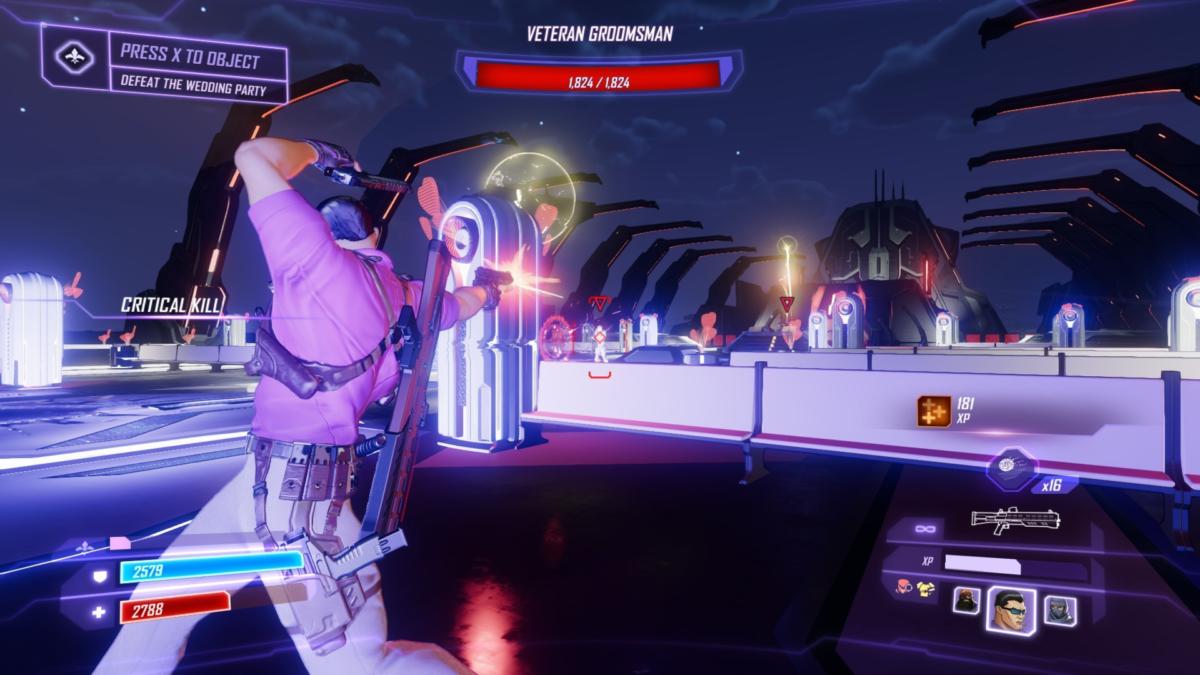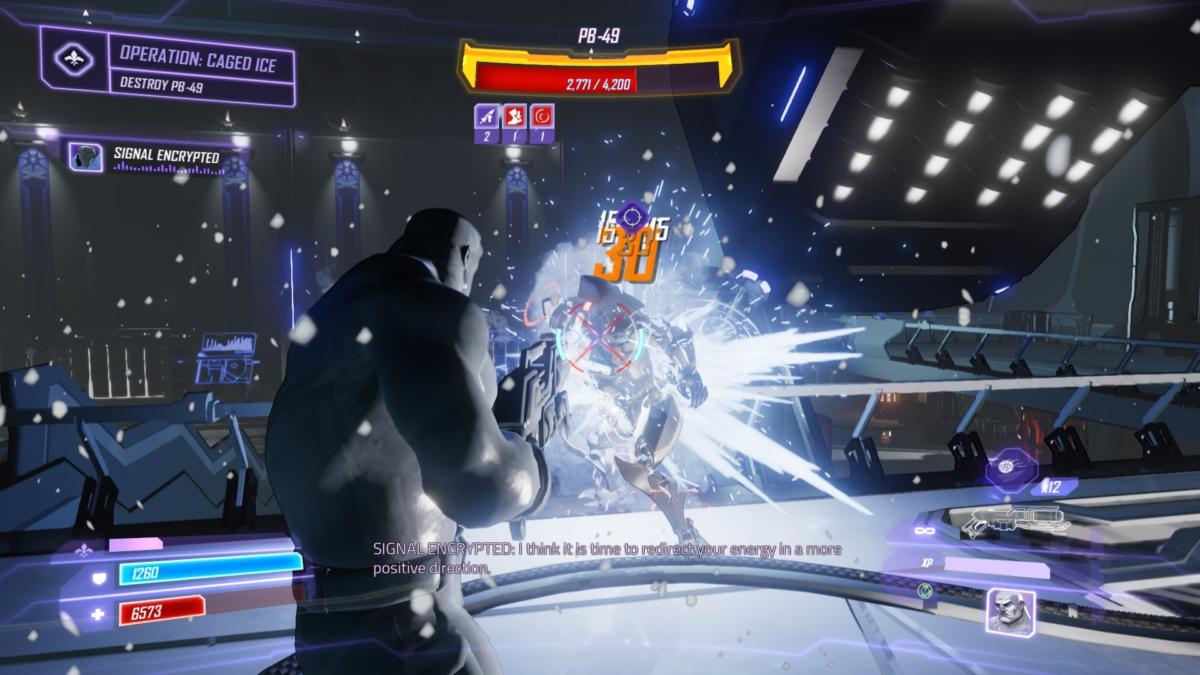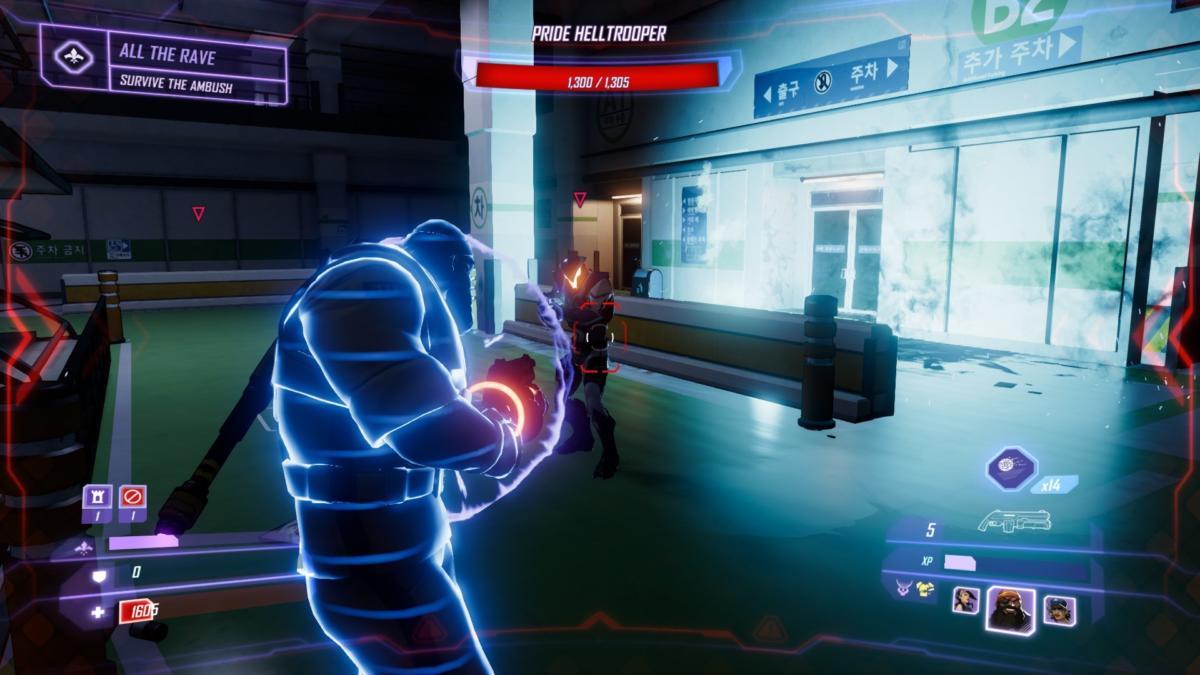Saint’s Row’s Achilles heel was always combat. It hid this fact by peppering each game with a handful of absurd weapons, from a recliner that fired missiles to the Dubstep gun to the iconic purple dildo bat—still the weapon I most associate with the series.
But even armaments that creative couldn’t hide the fact that combat was often a by-the-book affair. Enemies were brainless, and each encounter involved simply trying to get through it as fast as possible without dying. It’s telling that most of the memorable moments in Saint’s Row had nothing to do with combat, be it the Tron-esque “Deckers Die” mission, singing Biz Markie in a car with your friends, or an Aerosmith-backed rocket ride into space.
With that in mind…why build a Saint’s Row game around combat?
Peaceful easy feeling
Okay, it’s not “technically” Saint’s Row. That’s the most technical technicality I’ve seen in gaming though, given Agents of Mayhem’s propensity for purple fleur-de-lis, as well as the crossover presence of multiple characters (including face-of-the-series Johnny Gat if you get the DLC).

IDG / Hayden Dingman
Agents of Mayhem is a spin-off, abandoning the Third Street Saints to focus on a G.I. Joe-style conflict between the good guys at M.A.Y.H.E.M. and the evildoers of L.E.G.I.O.N. Headed by Dr. Babylon, LEGION’s goal is the usual take-over-the-world nonsense of Saturday morning cartoons, and the game has you traipsing around Seoul, South Korea trying to head off various doomsday plots.
It’s a stellar concept, and props to Volition for leaning into it. Nearly every mission begins and ends with a short hand-animated cartoon, and I can’t imagine how much work went into these. Battleborn had one short segment like this. Agents of Mayhem must have nearly an hour of cartoon in its 15 to 20 hour runtime. The quality ranges from excellent to lackluster, but in any case a lot of effort went into presentation.
If only the rest of the game were as creative.
Agents of Mayhem is boring. There’s no way around it. My first instinct was to blame the writing, because there are certainly a bunch of story beats that don’t land. (More on that later.) After thinking on it though, it’s clear that the bigger issue is the rigid and repetitive mission structure, which completely undercuts any potential strengths in the writing.

IDG / Hayden Dingman
There are 57 story missions in Agents of Mayhem. At least 45 of them are clones. You go to a marker on the map to begin the mission—a start point that is always, inexplicably, at least a minute’s drive from wherever the realaction of the mission is, so every mission begins with a lengthy drive to your true objective as MAYHEM’s handlers chatter in your ear. Wasted time.
Upon arrival, there are two ways it could go:
1) You enter an area and are forced to hold off waves of the same five enemy-types for some random period of time, then go to another area and do the same, then go to a third area and kill more baddies, maybe blow up a couple of random items, and the mission ends.
2) You go underground into a LEGION lair, which is actually maybe a dozen copy-pasted rooms snapped together at random with no interesting features or regard to level design, with hallways that literally end in dead-ends if you go off the beaten path, so you follow the mission marker from room to room and kill all the enemies inside or occasionally “hack” three terminals by doing a button-timing minigame.
The other 12 or so missions aren’t much better, but at least end with some sort of climactic boss fight or try to break out of the box. One mission, for instance, has you retracing your steps the day after a drunken bender, trying to figure out what you did the night before. Each moment still breaks down to “Kill lots of random enemies,” but at least the setup is slightly more creative than just “You’re in this generic lair, now shoot stuff.”

IDG / Hayden Dingman
Non-story missions and side content are even less inspired, seemingly just spawning into the world at random and consisting of either car races, foot races, or “Kill all enemies in this area.” Worse: They come back. You never really make progress on this front, because LEGION is constantly retaking the outposts you’ve conquered and repopulating the map with meaningless #content.
This is a side effect of the central hook. See, in Saint’s Row you played as a single character. In Agents of Mayhem, you’ll notice it’s “Agents” plural. There are 12 characters on offer (13 with the Johnny Gat DLC), and you can control three at any given time. Like Overwatch or another hero shooter, but a singleplayer open-world game.
Each character is, in Saturday morning cartoon fashion, a standard stereotype. There’s chaingun-wielding roller derby player Daisy, shotgunning ex-sailor Hardtack, ninja Scheherazade, and more. All 12 have unique weapons, as well as unique secondary and ultimate abilities—actor Hollywood, for instance, causes action-movie pyrotechnics to explode around him during his ultimate.

IDG / Hayden Dingman
Characters are a mixed bag, with some (angry Russian guy) being a complete dud, but again it’s clear Volition put a ton of work into this. Every character has a unique response for every single line of dialogue, so depending on who you’re playing as you’ll hear entirely different conversations. Pretty cool, though in practice it means dialogue varies wildly from “Solid” to “Lowest-Hanging Fruit,” and when you’re playing a dud character and a line dies on the vine it’s frustrating to wonder what better responses are hidden in the dialogue banks of characters you weren’t currently playing. It also means you’re likely to ignore some fun-playingcharacters just to hear decent dialogue from the handful of better-written characters on offer.
The variety of characters on offer brings me to my point about side content though. There’s never any real progress in the city front because Volition clearly wants you to run missions repeatedly, leveling up every character over time. There has to be enough stuff on offer to get all your characters to Level 20—an undertaking that, I think, would take anywhere between 30 to 50 hours. Whether anyone will actually do that? Well, I’m sure someone will. I won’t though, and so it just leaves the city feeling painfully lifeless and nonreactive. Beginning to end, basically nothing about Seoul changes.
.[Source”CNBC”]







